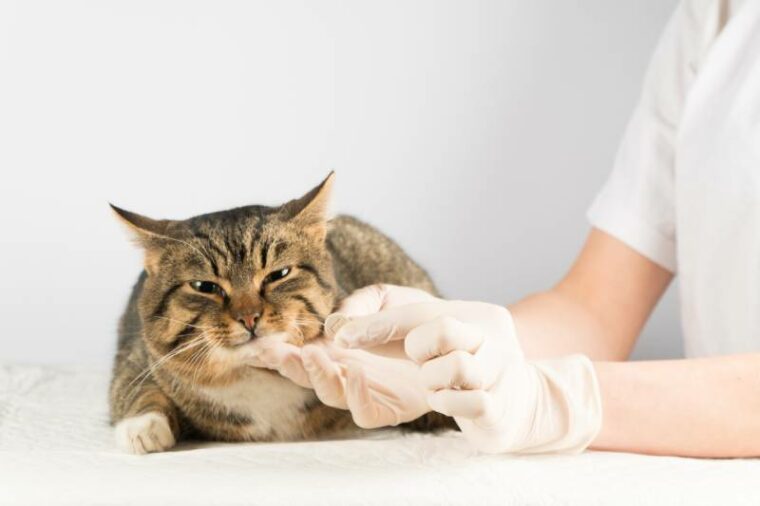
Click to Skip Ahead
Itching, especially overgrooming, is one of the most likely dermatologic reasons for a cat to see a veterinarian. Sometimes we’ll think overgrooming is a stress issue, but a recent study showed that in a group of cats presenting for suspected “psychogenic alopecia” (behavioral or stress overgrooming) in all but 10% of the cats1, another cause, such as allergies, parasites, hyperthyroidism was found to be the cause. This shows stress overgrooming is likely over-diagnosed, and we’re missing the real cause for overgrooming to the point of hair loss and skin lesions.
Read on to learn why you may or may not want to try an antihistamine for your cat with allergies and our review of some of the best options your veterinarian might recommend.
What Are Allergies?
Allergies, by definition, are a response in the body against something, in which the body releases histamines when it recognizes that something. Knowing this, it makes sense that antihistamines are the most common way to treat allergies in people. Block the release of histamines, and you keep allergy symptoms from happening.
There are a lot of ways to go about treating itchiness, especially from allergies, in a cat. There are several benefits to choosing an antihistamine to treat allergies in a cat, but there are several complicating factors too that will influence whether a veterinarian decides to trial antihistamines in an itchy cat.
The 5 Best Antihistamines for Cat Allergies
1. Benadryl (Diphenhydramine)
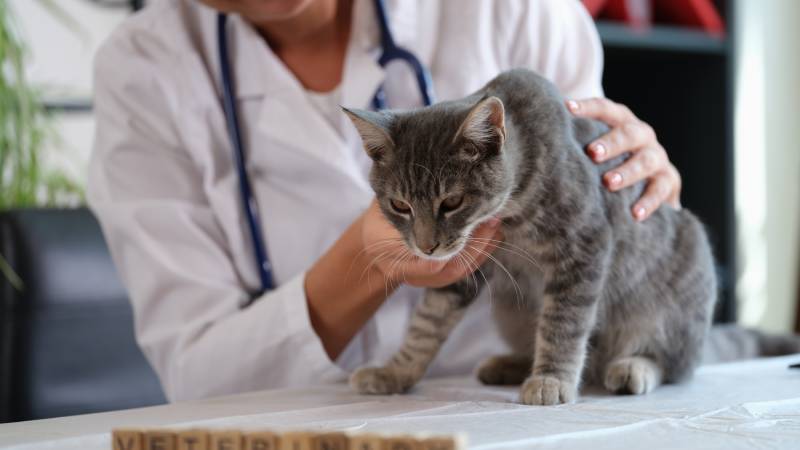
| Dosing Frequency: | Every 8–12 hours |
| Formulation: | Tablets, capsules, oral liquids, topicals, injections |
| Prescription Required?: | No |
| Generation: | First |
| Important Side Effect: | Drowsiness |
Benadryl is the classic antihistamine for pets. It’s usually the only one available within a veterinary clinic and has several other uses beyond the treatment of allergies. In general, antihistamines take time to work and work best when already in use before itching starts, but Benadryl is generally considered more likely than others to work for immediate relief. While it can make a cat drowsy, this effect usually lessens over time with daily use.
2. Claritin (Loratadine)
| Dosing Frequency: | Once daily |
| Formulation: | Tablets, oral liquids |
| Prescription Required?: | No |
| Generation: | Second |
| Important Side Effect: | None |
Loratadine is incredibly safe to use with no established side effects though it’s used with caution in cats with dry eye conditions or significant renal or liver disease based on side effects in humans. The once-daily dosing and tiny tablet size of which you only usually give half, makes it easy to give to cats. This antihistamine also doesn’t cause drowsiness. Since it isn’t used in pets as much or for as long as some other medications, its actual efficacy is only anecdotal.
3. Zyrtec (Cetirizine)
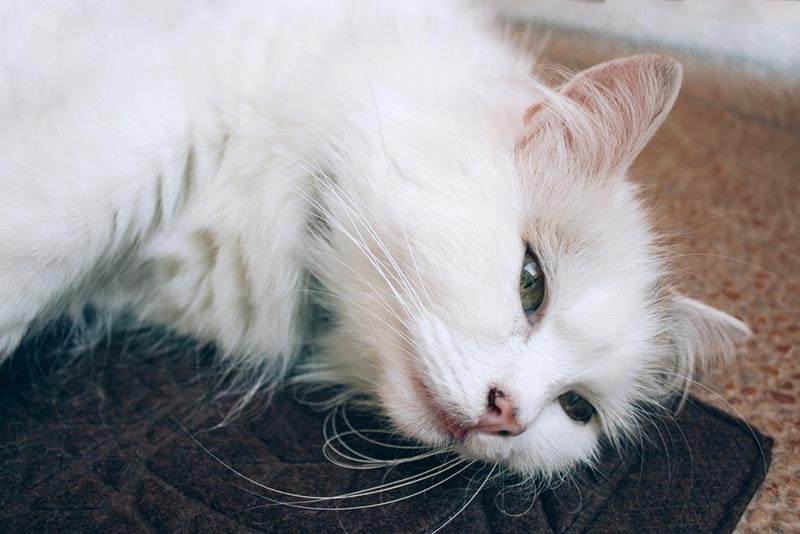
| Dosing Frequency: | Once to twice daily |
| Formulation: | Tablets and oral liquids |
| Prescription Required?: | No |
| Generation: | Second |
| Important Side Effect: | None |
Like Claritin, Zyrtec is generally very safe in cats. The official dosing for this medication is once daily but anecdotally it may work better with twice daily dosing and seems to be safe dosed either way. Despite being a second-generation antihistamine, it is possible for this medication to cause drowsiness in small animals like cats, especially at high doses. The liquid and dissolving tablet forms of this medication should be avoided in cats as they can contain propylene glycol and xylitol which are toxic.
4. Chlor-Trimeton (Chlorpheniramine)
| Dosing Frequency: | Every 8–24 hours, usually every 12 hours |
| Formulation: | Tablets and oral liquids |
| Prescription Required?: | No |
| Generation: | First |
| Important Side Effect: | Drowsiness |
Chlorpheniramine is often found in cold medications for humans mixed with other medications in one product. Formulations of just chlorpheniramine can be more common in animal medicine than in humans, and so sometimes this medication is a little harder to find than other antihistamines. It is important to not use any of the forms that are mixed with other medications in cats as the other components are typically unsafe for them. The product itself alone, though, is generally safe and well tolerated in cats, and like Benadryl, drowsiness can lessen over time with daily use.
5. Vistaril (Hydroxyzine)
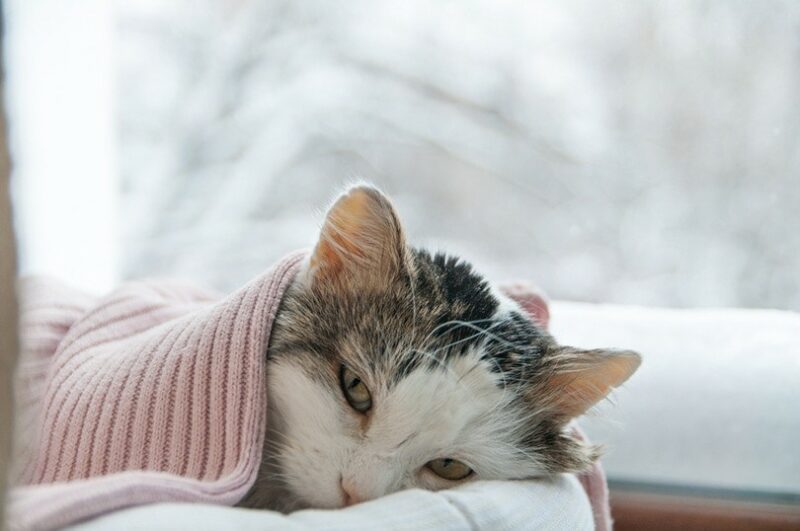
| Dosing Frequency: | Every 12 hours |
| Formulation: | Tablets, capsules, oral liquids, injections |
| Prescription Required?: | Yes |
| Generation: | First |
| Important Side Effect: | Drowsiness |
Hydroxyzine is the only antihistamine on this list that requires a prescription. The reason it is included is there is some evidence it may be more effective than other antihistamines in dogs, which could potentially, therefore, be true in cats also, so some veterinarians prefer it. This medication affects the central nervous system more than other antihistamines, which means it can cause more sedation, but also means if there is a stress-related component of overgrooming behaviors in the cat, this may help more in that cat.
The dosing frequency of this medication is well established, and it has been in use for a long time compared to second-generation antihistamines, but it does have more side effects than other antihistamines.
Buyer’s Guide to Antihistamines for Allergies in Cats
The decision of which antihistamines to try for treatment of allergies in cats is heavily informed by how important various formulation options or minimal dosing frequency is, whether a cat has any other health conditions that make antihistamines less safe for them, and the experiences of the prescribing veterinarian.
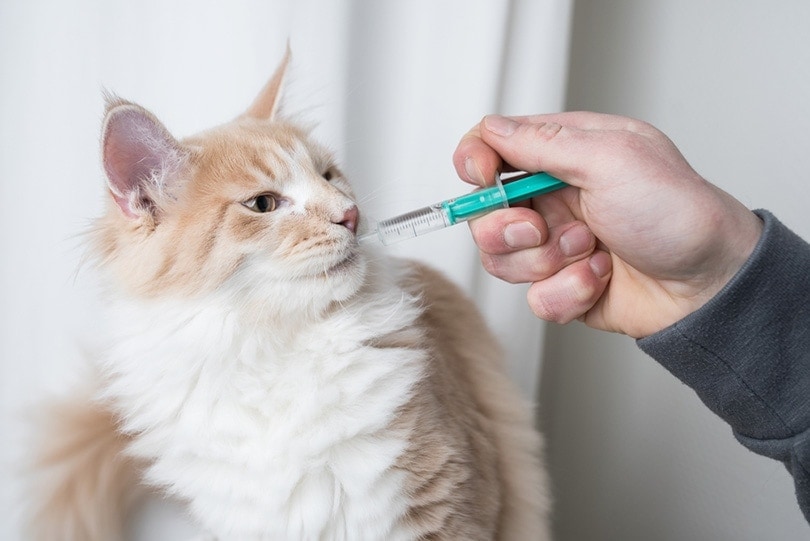
Pros of Antihistamines for Allergies in Cats
Most antihistamines come with very few side effects and are generally considered very low-risk medications.
They do come in two types: first-generation and second-generation. First-generation antihistamines can make a cat drowsy, while second-generation antihistamines generally don’t.
Antihistamines are generally considered affordable. They’re also usually accessible because most are available over the counter. In fact, this list only contains one antihistamine that requires a prescription.
Many antihistamines require once-daily dosing, which is very helpful when convincing your cat to cooperate with their treatment plan.
Since antihistamines are so commonly used in people, they’re far easier to pick up than some pet-specific medications. Any pharmacy will have them but so will grocery stores, gas stations, convenience stores, travel hubs, and online retailers, to name a few.
Cons of Antihistamines for Allergies in Cats
While antihistamines are usually the first choice for the treatment of allergies in people, you may find this isn’t true for cats with most veterinarians. The reason?
They don’t seem to work consistently. How frustrating is that? There are many different available antihistamines, but no one antihistamine has been shown to work better than others in any studies, and some have never been proven to work at all.
As best we can tell, any antihistamine has a chance to work for a cat with allergies, but you won’t know until you try it. It’s impossible to predict ahead of time. From experience, I can say the first-generation antihistamines seem a bit more likely to work, but they also consistently cause drowsiness, while second-generation antihistamines most likely won’t have any side effects at all.
All this means that to try and treat allergies in cats with antihistamines usually means signing up for several weeks to months of changing medications every couple weeks until you find one that works if you find one that works.
Studies also seem to indicate that antihistamines are unlikely to work for cat allergies unless they’re mild. Pairing them with omega-3 fatty acid supplementation seems to help with their efficacy, but that is, of course, adding an additional item to a cat’s treatment list, which is usually not appreciated by the kitty.
Another issue with antihistamines is that, although they’re available over the counter and generally considered safe, different antihistamines do have contraindications for certain problems. Some may not be safe with a specific medication; others aren’t safe in cats with kidney disease. Just because these medications are available over the counter for humans doesn’t mean you should swing by your local store to try one out without consulting with a veterinarian first. The safest way to choose and dose an antihistamine is to do so under the direction of your veterinarian.
Lastly, not all allergies should be treated with allergy medication! I know that sounds crazy, but a common cause of allergies in cats is their diet, meaning the treatment of choice is a diet change rather than medication. Allergies to insects and insect bites and fleas should be treated with parasite preventatives. Then, of course, cats can really have any combination of the different types of allergies, so this is another reason to always consult with a veterinarian first before pursuing treatment, even with something as safely and widely available as antihistamines.
Conclusion
If any of these antihistamines appeals to you and your cat, be sure to check in with your veterinarian about whether starting them is possible. There are even more antihistamines than this list covers, and anxiety medications even that can have an antihistamine effect in cats, but these are the most immediately relevant and common options available for pet owners.
I have used every medication on this list in patients before without any reactions or side effects and recommend exploring them as options with your veterinarian if you think it may be appropriate.
An important takeaway is that many antihistamines may cause drowsiness, but this usually resolves entirely within one to two weeks of daily use. Antihistamines work best with continuous use rather than only when flare ups occur, and they work best in conjunction with other interventions such as omega-3 fatty acids or steroids.
We hope we’ve given you everything you need to know about selecting an antihistamine for your cat and how best to go about starting the process of giving this medication if needed.
Featured Image Credit: Irina 1 Nikolaenko, Shutterstock







